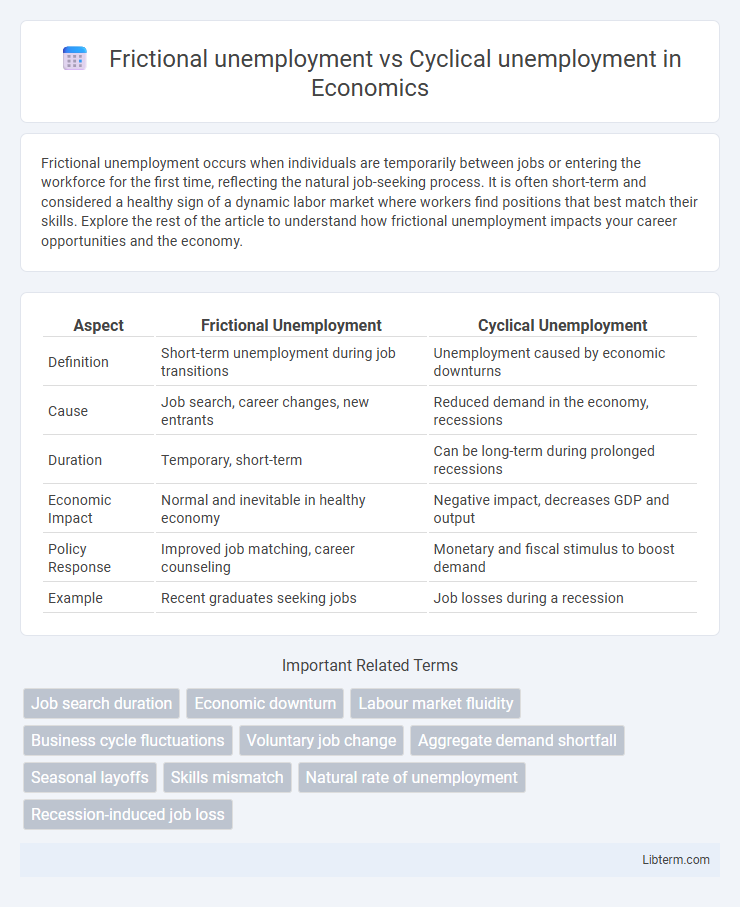Frictional unemployment occurs when individuals are temporarily between jobs or entering the workforce for the first time, reflecting the natural job-seeking process. It is often short-term and considered a healthy sign of a dynamic labor market where workers find positions that best match their skills. Explore the rest of the article to understand how frictional unemployment impacts your career opportunities and the economy.
Table of Comparison
| Aspect | Frictional Unemployment | Cyclical Unemployment |
|---|---|---|
| Definition | Short-term unemployment during job transitions | Unemployment caused by economic downturns |
| Cause | Job search, career changes, new entrants | Reduced demand in the economy, recessions |
| Duration | Temporary, short-term | Can be long-term during prolonged recessions |
| Economic Impact | Normal and inevitable in healthy economy | Negative impact, decreases GDP and output |
| Policy Response | Improved job matching, career counseling | Monetary and fiscal stimulus to boost demand |
| Example | Recent graduates seeking jobs | Job losses during a recession |
Introduction to Unemployment Types
Frictional unemployment occurs during the normal turnover in the labor market as workers transition between jobs or enter employment for the first time, reflecting short-term mismatches and search processes. Cyclical unemployment arises from economic downturns or recessions, directly linked to fluctuations in aggregate demand causing widespread job losses across industries. Understanding these two types helps in designing targeted labor policies, where frictional unemployment is addressed through job matching and training programs, while cyclical unemployment requires macroeconomic stimulus to revive demand.
Defining Frictional Unemployment
Frictional unemployment refers to the short-term joblessness that occurs when workers are between jobs or entering the labor market for the first time, reflecting the natural movement of labor as individuals seek better employment opportunities. Unlike cyclical unemployment, which results from economic downturns and reduced demand for labor, frictional unemployment persists even in a healthy economy due to the time required for matching employers with suitable employees. This type of unemployment is essential for a dynamic labor market, enabling efficient job matching and career transitions.
Defining Cyclical Unemployment
Cyclical unemployment refers to joblessness caused by fluctuations in the economic cycle, typically rising during recessions when demand for goods and services declines and falling in periods of economic growth. It contrasts with frictional unemployment, which stems from normal labor market turnover as workers transition between jobs. Understanding cyclical unemployment is crucial for policymakers aiming to implement fiscal or monetary measures that can stimulate demand and reduce labor market slack during economic downturns.
Key Differences Between Frictional and Cyclical Unemployment
Frictional unemployment arises from short-term transitions as workers search for suitable jobs, reflecting the natural job turnover in a healthy economy. Cyclical unemployment occurs due to downturns in economic activity during recessions, causing widespread job losses linked to reduced demand. The primary difference lies in frictional unemployment being voluntary and temporary during job matching, while cyclical unemployment results from insufficient aggregate demand and fluctuates with the business cycle.
Causes of Frictional Unemployment
Frictional unemployment arises primarily from the time workers spend searching for new jobs that better match their skills and preferences, often influenced by voluntary job changes, geographical relocation, or entry into the labor force. Factors such as information asymmetry, changes in consumer demand, and mismatches between job vacancies and job seekers contribute significantly to frictional unemployment. Unlike cyclical unemployment, which fluctuates with economic downturns, frictional unemployment persists even in a healthy economy due to the ongoing job search process.
Causes of Cyclical Unemployment
Cyclical unemployment arises primarily from fluctuations in the business cycle, where economic downturns lead to reduced consumer demand and decreased production, causing widespread job losses. In contrast, frictional unemployment is caused by temporary mismatches between job seekers and available positions during normal labor market transitions. The root cause of cyclical unemployment lies in recessions or economic slowdowns, which significantly reduce overall employment opportunities.
Economic Impact of Frictional vs Cyclical Unemployment
Frictional unemployment causes short-term joblessness as workers transition between jobs, leading to minimal negative impact on overall economic output and allowing natural labor market adjustments. Cyclical unemployment arises from economic downturns, resulting in significant declines in aggregate demand, reduced production, and increased fiscal strain due to higher unemployment benefits and lower tax revenues. The economic impact of cyclical unemployment is more severe, often requiring targeted monetary and fiscal policies to stimulate growth and reduce joblessness.
Examples of Frictional and Cyclical Unemployment
Frictional unemployment occurs when individuals voluntarily leave jobs to find better opportunities or are temporarily transitioning between roles, such as a recent college graduate searching for their first job or a worker relocating to a new city. Cyclical unemployment arises from economic downturns, exemplified by factory workers laid off during a recession or retail employees losing jobs due to decreased consumer spending in a market slump. These contrasting examples highlight frictional unemployment's basis in job search dynamics versus cyclical unemployment's dependence on macroeconomic conditions.
Policy Approaches to Address Each Type
Policy approaches to frictional unemployment emphasize enhancing labor market information systems, job matching services, and unemployment benefits reform to reduce search time and improve worker mobility. Cyclical unemployment is addressed through countercyclical fiscal policies such as increased government spending and tax cuts, alongside monetary policy measures like interest rate adjustments to stimulate aggregate demand. Targeted training programs and incentives for job creation also form critical components in mitigating both types of unemployment.
Conclusion: Understanding Unemployment Dynamics
Frictional unemployment reflects the short-term job search process as workers transition between roles, highlighting labor market flexibility and information flow. Cyclical unemployment results from economic downturns, indicating insufficient demand and requiring policy intervention to stimulate growth. Understanding these distinctions is essential for designing targeted employment policies and stabilizing the economy.
Frictional unemployment Infographic

 libterm.com
libterm.com